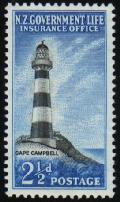 |
New Zealand Lighthouse Stamps - N. Z. Government Life Insurance |
Issues: 1891 | 1905 | 1947 | 1967 | 1969 | 1976 | 1981 | MODERN ISSUES | NZ LIGHTHOUSE MAP | STAMP VALUES | CATALOGUE NUMBERS | COVERS | LIGHTHOUSE LINKS | CONTACT |
HOME
> STAMP SITES > LIGHTHOUSE STAMPS
 |
New Zealand Lighthouse Stamps - N. Z. Government Life Insurance |
Issues: 1891 | 1905 | 1947 | 1967 | 1969 | 1976 | 1981 | MODERN ISSUES | NZ LIGHTHOUSE MAP | STAMP VALUES | CATALOGUE NUMBERS | COVERS | LIGHTHOUSE LINKS | CONTACT |
WELCOME
to this page about New Zealand Government Life Insurance postage stamps. |
|
What is an insurance business doing with its own stamps? A philosophy held by New Zealand Governments until the late 20th Century was that it was a good idea for government to be involved in many fields of commerce - so as to keep the others honest. Insurance was one of those fields. The Government started a Government Life Insurance Department in 1869. It did not restrict itself to life insurance and late in its existence sold other sorts of policies. A lighthouse was used as its corporate symbol. When sea travel was the only way New Zealand was linked to the rest of the world and a common experience of many, the symbolism of safety aligned with a lighthouse must have been more powerful than perhaps it is today. As a government insurance business, it gained the right to use its own stamps after disagreements with the Post Office about how much postage it owed. Of course it chose to use lighthouses on its stamps. The stamps were available to collectors through the post office but were never authorised for general use. First day covers were available to general purchasers. Only the business could use them for general postage though there was an exception applying only on the first day of issue of the 1947 series. The words New Zealand do not appear on any of the stamps - only the common abbreviation, N.Z. Nor did the monarch's portrait ever appear in the series. These are both indications of how the series was kept separate from the normal issues of the Post Office. Customers and agents of the business who were also philatelists then collected a small bonus in postally used stamps. Postally used stamps of the 1947 onwards issues are not that common and some catalogues even show them at a premium over mint. Few were used internationally. The name of the business changed from "Department" to "Office" and this shows on the later stamps. In reality the insurance operation which went under the Government's name was a mutual insurance company with a relatively light Government involvement. In 1989 the Government stepped back from any involvement leaving it entirely in the hands of the policy holders. Consistent with this the "government" part of the name was dropped and it became Tower Insurance. It de-mutualised in 1999 and is now Tower Corporation. The use of the name Tower and the ongoing use of a lighthouse as a corporate symbol reflects its history. It has recently issued stamps again - through NZ Post
James Cook's name appears often in the story about the naming of the various sites. That is not surprising given that his first voyage, on Endeavour, was the first to circumnavigate New Zealand (1769-70) and that one of his major tasks was to map the places he explored. He produced the first chart of the whole of New Zealand. Most of the names he gave have stuck ever since. He also named places after members of his ship's crew though these do not appear here. Rather it is a collection of names of people who never visited New Zealand. See: James Cook on Stamps
In 2000 New Zealand produced a stamp of Taiaroa Head depicting the lighthouse, in its definitive scenic stamps series:
An earlier stamp (1996) in the same
series showed Cape
Reinga - with the lighthouse shown in the middle distance. Then it poured Reinga stamps:
A cover from the former
Reinga Post Office:
A second outing for this light in 2003.
See more on these here. Universal Mail - an authorised mail operator in New Zealand - has produced lighthouse stamps. See Shades Stamp Shop for images. They have covered Cape Brett, Taiaroa Head (two variants), Cape Campbell and Cape Reinga lights. Here is one of them:
New Zealand Post 2005, part of a commemorative series of stamps on stamps. iN
2019 NZ Post produced a new series showing views out from some lighthouses.
The towers are represented by outline diagrams. The sites figured are: $1.20
Pouto Lighthouse, Northland, $1.20 Manukau Heads Lighthouse, Auckland, $1.20
Baring Head Lighthouse, Greater Wellington, $2.40 French Pass Lighthouse,
Marlborough, $3.00 Nugget Point Lighthouse, Catlins, $3.60 Puysegur Point
Lighthouse, Fiordland.
In 1988 a group of businesses around Otorohanga formed a document exchange and issued stamps. It was illegal and was subsequently closed down. It extended to the North Island west coast - hence the name and the symbol - which is not any particular lighthouse. FDC (thumbnail)
Values When New Zealand's lighthouses were being established New Zealand had few primitive roads. Servicing of almost all the lighthouses was by sea. The lighthouse tender vessels held an important place in the maritime history of the country. Now most of the lights are accessible by road but some on islands still require sea transport for major work, though helicopters are used for some of the visits. A light house tender ship captain for many years, Captain Bollons, accumulated a large collection of Maori artefacts through collecting at archaeological sites near the lights. His collection is now in Te Papa - the national museum in Wellington. New Zealand's First Permanent Lighthouse - Pencarrow Head. The usual date cited (1859) is for the cast iron lighthouse. There were earlier lights at the site. It was also the only light ever to have a woman keeper, who was the inaugural keeper of the iron tower. Read about the history of lights at the site here. The light is no longer in use but the tower is retained as a heritage feature.
A light which followed closely after was the Nelson light on the boulder bank, built by the Nelson provincial government and lit in August 1862. It was the second New Zealand light. There is not a stamp of it, but it ranks a mention here because the first light keeper, William Edward Cross, was my wife Miranda's great great grandfather. He was the brother of the harbour master James Cross. James Cross's house still stands in Nelson, overlooking the harbour at 24 Richardson St. Today it is an exclusive homestay Te Puna Wai.
Nelson Haven Lighthouse. It is of cast iron, imported in parts from England where it was made by Stothart and Pitt of Bath. There were once two lighthouse keepers cottages alongside. The lighthouse has a category 1 rating from the Historic Places Trust. It was automated in 1915 and decommissioned in 1982 when it was replaced by a new light elsewhere in the harbour.
With
the later cottages (Thumbnail).
One of the 1895 lighthouse keepers cottages still exists relocated to 66 Muritai St, Nelson, link.
In August 2012 the 150th anniversary of the first lighting was celebrated with a re-illumination by LED and the temporary floodlighting of the tower. The lens and gas light had been restored in 2008 but not lit. The light shone towards the land rather than the sea for the event. Government Involvement The construction of lighthouses had been reserved to the central Government rather than the provinces under the then constitution of New Zealand. Lighthouse expenditure was first funded by the Loan Appropriation Act of 1863. This legislation was a companion piece to the notorious New Zealand Settlements Act which authorised Maori land confiscations. Most of the loan funds were to be spent on the land war and the lighthouse expenditure was a sop to the southern interests, who were not directly affected by the war, a plain instance of pork barrel politics.
A few within harbours are maintained by Regional Councils.
?
|
1891 "V
R" The first insurance stamp of 1891 came in six values, but only one design. There is a "V R" across the centre of the stamp for Victoria Regina. W.B. Hudson and J. F. Rogers are credited with the design. |
|
|
1905 After an initial issue of the 1d and 2d in 1905/6 the insurance office was directed to use the new "official" overprinted stamps which it did from 1907 to 1913. From 1913 on the "No VR" stamps appeared again in a wider range of values and with some colour changes to match the equivalent values in the contemporary definitive KGV set. The re-emergence of the Government Life stamps is linked to the Post Master General of the day Sir R Heaton Rhodes, who was a prominent philatelist. His collection, specialising in early New Zealand stamps is still intact in the Heaton Rhodes room at the Canterbury Museum, Christchurch. Here is a history of the colour changes of this issue as it followed the definitive issue colours. The 1½d stamp illustrated is in fact an aberrant version having "Postage" in both side panels. The other values have the value in words on the right. Presumably "one and a half pence" would not fit. It was first issued in black but the cancellations could not be seen on black (the problem was with the colour matching KGV issue) and the colour was changed to brown. |
||
|
1947 (1
August) |
||
|
½d Castle Point 1913 The Castle Point Racing Club had its own stamp and commemorative cover for the 2010 meeting. Many of New Zealand's light towers were prefabricated ones imported from Britain. This was the last to be built that way. Many of this series also feature ships. There is one in this stamp just below the value. This light is reputedly haunted by the ghost of a keeper who fell to his death from the tower. This is the rarest stamp in the set. It went out of use without warning and dealers did not have large stocks of it. |
||
|
1d Taiaroa Head 1865 Sailing ships were a rare sight by 1947. This is the Barque "Pamir" which at that time was being operated by the Union Steam Ship Company of New Zealand on behalf of the New Zealand Government which had seized it as a "Prize of War" in Wellington in 1939. It was sailed mostly on Pacific routes from New Zealand to the West coast of the USA. It visited the Otago Harbour. In 1948 it was returned to its previous Finnish owners. More about the Pamir |
||
2d Cape Palliser 1897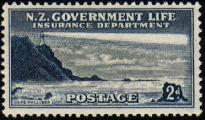 The south eastern tip of the North Island and at times, a place of very wild wind and waves. The name was given by Captain Cook after a naval colleague and patron who held the important post of Comptroller of the Navy Board. |
||
|
2½d Cape Campbell 1870 It has my vote at the best design of all the Government Life stamps. Cape Campbell was named by Cook after Captain John Campbell who had made advances in navigation instruments and had sponsored Cook. He also was a supporter of John Harrison, the famous maker of the first marine chronometers. Kendall's copy of Harrison's first practical chronometer, H4, accompanied Cook on his second and third voyages. This is not the original light tower but a replacement of 1905, built of cast iron panels made by Charles Judd of Thames. The Bella Street Pumphouse Museum in Thames has a super picture of the tower pre-assembled in Judd's yard. The 2½d letter rate ended soon after the stamp was issued. At the time the business made much use of postal metering machines so the stamp is rare used. |
||
|
3d Eddystone If you want to read about pioneering engineering this is a classic. The builder of the fourth light, John Smeaton, was the 18th century's greatest engineer. That tower is preserved in Plymouth after the sea undermined its foundation. The stamp is of the fifth tower of 1882, though not as it appears today. The keepers are Minnie and Henry Crun - see the Ten Snowballs that Shook the World. Apart from all that it is the subject of a rather good Victorian music hall comic song:
|
||
|
4d Stephens Island 1894 For a sad story read on. The new variety of wren, Lyall's Wren, Traversia lyalli was found on the island in 1894, by being caught by the new lighthouse keeper's cat. The cat caught 10 more which were dispatched to collector naturalists, no doubt for some monetary reward. After the 11th catch the bird has never been seen again. According to one source "...the cat which discovered the species also immediately exterminated it." Lyall's Wren formerly also existed on the mainland. The relict population on Stephens Island was because of the lack of predators there - until the cat arrived. Bird collectors obviously helped in its final extinction on Stephens Island, as may the clearance of the bush on the island by the lighthouse keepers. Piopio, saddlebacks and kokako were lost to the island as well. Just to balance the number of references to Cook on this page, in 1642 the two ships of the first European navigator to visit New Zealand, Abel Tasman, anchored off Stephens Island for three days sheltering from a storm. They did not go ashore here (or anywhere else in New Zealand). He was thwarted in his desire to explore eastward, being over-ruled by a council of the officers he was obliged to call. Otherwise Cook Strait might have been Tasman Strait. |
||
6d The Brothers 1877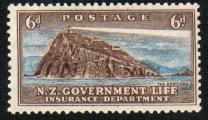 The Brothers are two islands at the north eastern tip of the South Island, in Cook Strait. Cook named them. It was the last lighthouse to be de-manned - (1990). It also appeared on a 1974 stamp in the scenic series - off-shore islands.
|
||
|
1/- Cape Brett 1910 Cape Brett is at the southern entrance to the Bay of Islands on the northern coast of the North Island. Here is some more about the light: Link. Its now disused - replaced by a beacon in front of the tower. The tower is built of cast iron panels made by Charles Judd of Thames. Brett is a Cook name - after a British Admiral, Sir Percy Brett. The island in the background is Piercy Island - a punning Cook name referring to the hole which goes right through the rock at sea level. Piercy was yet another British admiral. The island is a favourite for New Zealand stamps: Second pictorial, Modern self adhesive Universal Mail also has a $1.50 value stamp depicting the island. Tourist trip launches pass through this hole in fair weather. |
||
|
1967 (10
July)
1969 Decimal Series: The 1969 series was again the work of designer James Berry. He was a conservative designer. Over his career his designs moved from ones with elaborate frames, to ones with lined frames like the 1947 series, to unframed designs like this series. He was red / green colour blind - an unusual thing for a graphic artist but most of his early career was in producing black and white commercial art for newspapers and magazines. None of the designs here have contrasting red and green. The issue coincided with the centennial of the Government Life so the motivation for the new issue was more than converting to decimal currency. |
||
|
½c Moeraki Point 1878 The props around the tower were added soon after it was built to stiffen it. Moeraki is a Maori name meaning "drowsy day. This is the rarest stamp of the set as the value had little use in postage rates. |
||
|
2½c Puysegur Point 1879 This stamp also exists overprinted as 25c value. This was issued in 1978. Curiously it was not the left over stamps from the earlier issue which were overprinted, but a new printing. The new printing was perforated p14 whereas the original was p13½ x13. |
||
|
3c Baring Head
1934 Baring was a director of the New Zealand Association, the forebear of the New Zealand Company which brought British settlers to the Wellington district. |
||
|
4c Cape Egmont 1881 Here is a cover that
marked the centenary of the lighthouse, and a postcard of the light using
the stamp: |
||
15c Dog Island 1865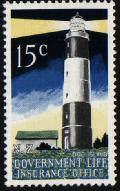 Dog Island is a low lying island in Foveaux Strait at the far south of the South Island. It is built of stone quarried on the island. The strait is famous for oysters caught by a fishing fleet based at Bluff Harbour. There is an airstrip on the island making this an easy light to service. It is New Zealand's tallest lighthouse. |
||
|
1976-78 New Decimals
|
||
8c East Cape 1922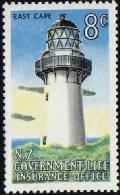 The eastern most point of the North Island. A prosaic name. It escaped Cook's naming though he saw and mapped the point. This light replaced an earlier one on a small offshore island first lit in 1900. In fact the tower was relocated and was shortened in the move. The tower is built of cast iron panels made by Charles Judd of Thames. For more information: LINK |
||
10c Farewell Spit 1870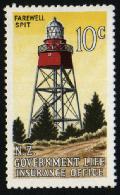 The spit is a long boulder bank at the South Island north west extremity. The name is Cook's again - named when he left New Zealand from this coast in 1770. My wife's family once had a dachshund which was bred by the light house keepers. The present steel framed tower dates from 1897. The original was of wood. The spit is a Ramsar Convention nominated wetland.
|
||
|
1981 Series |
||
The lighthouse names are hotpoint linked to the stamps. There are many more lighthouses - only those on stamps are shown.
Google Earth file of these locations - download
Te Ara encyclopaedia article on lighthouses Shades Stamp Shop stocks these issues with lots of cinderellas as well NZ Post page on Government Life Stamps - and there is the Lighthouse Stamp Society Jan Langenberg has a site which includes a section on lighthouses. Klaus Huelse's Lighthouse Stamp Site Jonas Vogt's lighthouse site New Zealand Lighthouses
OTHER COUNTRIES
Many other countries have used lighthouses on stamps.
CANADA has produced several sets of lighthouse stamps showing the flash sequence of each light: |
|
BRITAIN has its own stamp of Eddystone. This is not the modern tower.
Here is a Link to a site about this stamp and other UK lighthouse issues.
ACKNOWLEDGMENTS
STEVEN McLACHLAN, Shades Stamp Shop, who kindly added some information.
Thanks to Grant and Tracey's Lighthouse Page.
Murray Sime - for information and images.
An Encyclopaedia of New Zealand 1966.
J.C. Beaglehole. A Life of Captain James Cook. 1974.
J. O'Connel Ross. The Lighthouses of New Zealand. 1975.
Robin Gwynn. Collecting New Zealand Stamps. 1988.
D.E.G Naish and K.J. McNaught (Eds.) The Postage Stamps of New Zealand, Vol VI.
B.G. Vincent. (Ed.) The Postage Stamps of New Zealand, Vol VIII. 1998.
Government Life 1986, Government Life Postage Stamps 1891-1981, Wellington.
J. R. Tye, The Image Maker - The Art of James Berry. 1984, Hodder and Stroughton, Auckland.
Helen Beaglehole. Lighting the coast; a history of New Zealand's coastal lighthouse system. Canterbury University Press, 2006.
Eddystone Light
My father was the keeper of the Eddystone light
And he slept with a mermaid one fine night
Out of this union there came three
A porpoise and a porgy, and the other was me!
Yo ho ho, the wind blows free,
Oh for the life on the rolling sea!
One night, as I was a-trimming the glim
Singing a verse from the evening hymn
I head a voice cry out an "Ahoy!"
And there was my mother, sitting on a buoy.
Yo ho ho, the wind blows free,
Oh for the life on the rolling sea!
"Oh, what has become of my children three?"
My mother then inquired of me.
One's on exhibit as a talking fish
The other was served in a chafing dish.
Yo ho ho, the wind blows free,
Oh for the life on the rolling sea!
Then the phosphorus flashed in her seaweed hair.
I looked again, and my mother wasn't there
But her voice came angrily out of the night
"To Hell with the keeper of the Eddystone Light!"
Yo ho ho, the wind blows free,
Oh for the life on the rolling sea!
Contact E-mail: G Law
Last Updated: 08 August, 2019